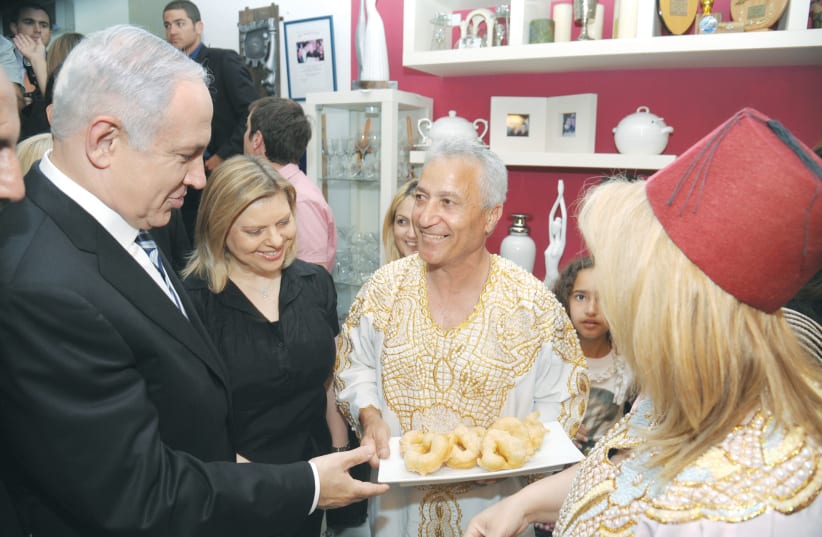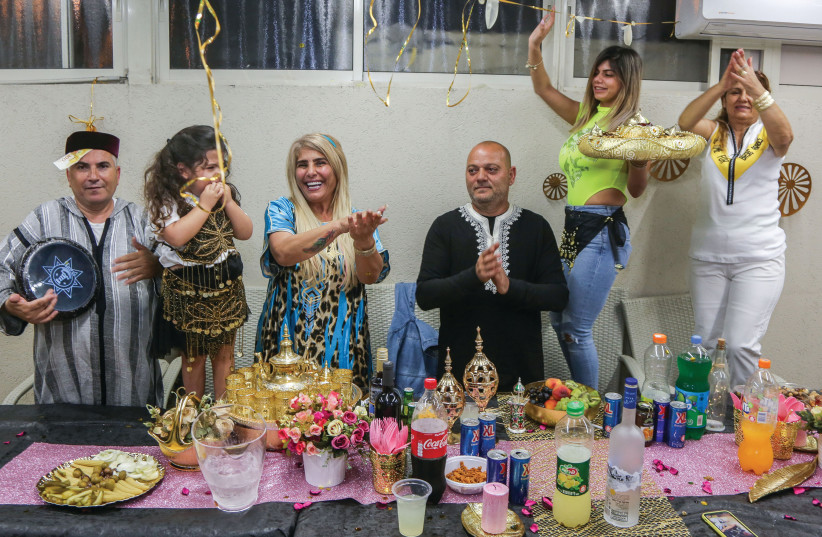The Mimouna is one way of quickly getting out of Passover mode. In Israel, Mimouna is an official post-Passover festival, with mofletas (a Maghrebi Jewish pancake) in the evening and barbecues the following day. But Mimouna is not a universal Jewish festival, as indicated by the Nessah Synagogue in Beverly Hills, California, which organized a post-Passover, community Challah baking. In case any reader jumps to the immediate conclusion that Nessah is an Ashkenazi congregation, that premise could not be more incorrect.
As it happens, Nessah Synagogue is believed to be the largest traditional Persian congregation in the United States and in addition to religious services, runs a nursery and Hebrew School programs.
The challah bake was led by Rabbanit Shira Melul. With a surname like that, it is most unlikely that she is Ashkenazi and most certainly, her husband is not.
Actually, it worked out very nicely this year, given that the day after Passover was the day before the Sabbath so participants in the Challah bake will be able to consume the work of their hands at traditional Friday night dinners.
■ WHILE THE Moroccan Jewish community introduced the Mimouna to Israel, the Kurdish community introduced the Saharana.
Like the Mimouna, the Saharana is actually a Spring festival that was originally celebrated during the intermediate days of Passover but because people wanted to avoid a clash between the two, the celebration of the Saharan was shifted to Sukkkot.
The central Mimouna festivities were different this year because, for the first time ever, the Knesset hosted a Mimouna celebration, which is not exactly surprising considering that Knesset Speaker Amir Ohana is of Moroccan parentage.
An invitation to the public was issued on the Knesset’s website with a video of Ohana leaning across his desk, saying, “Citizens of Israel of all ethnic groups, shades and genders, I wish to invite you to the Knesset on Wednesday night, April 12, after the Passover holiday ends to celebrate the Mimouna here for the first time. I invite you to come and join the music, the colors and the culture and also the beauty this holiday has to offer – bonding the people of Israel together. So come join us and in the words of the traditional greeting: Tirbahu wa-tisadu.”
The first public Mimouna celebration was in the Herzl Forest in Lod, with some 300 participants. A year later, it was held at Sanhedrin Park in Jerusalem with a much larger attendance. But within a relatively short space of time, this public space became too small, as the attendance has expanded to thousands.
In 1971, the festivities in Jerusalem moved to the much larger Sacher Park and other cities also began to host public Mimouna celebrations, with the central celebration usually held in a different city each year.
In the course of time, the Mimouna became a place where politicians could meet their constituents in a happy and friendly environment. Moreover, it was well covered by television and print media, which enabled attending politicians to get more exposure.
Elsewhere in Jerusalem on Wednesday night, the courtyard of the Khan Theater had a somewhat more authentic environment because its architecture dates back to the Ottoman era. Its entertainment lineup also included the Arenas, a trio that takes its name from the Arenas transit camps in Marseilles, where thousands of Moroccan refugees, mostly Jews, were housed in the 1960s. Singer Neta Elkayam and keyboard instrumentalist Amit Hai Cohen researched the archived sounds of the women of the Atlas mountains that echoed through the transit camps, and together with trumpet player Tal Avraham created a musical legacy that they have taken to Europe and the United States, stirring the souls and the memories of thousands of people of Moroccan ancestry.
In both the Knesset, the Khan and many other venues in Jerusalem and around the country it literally rained on their parades. But the inclement weather was no deterrent.
Mimouna is party time and people wanted to party despite having to walk in puddles and being drenched by cloudbursts. President Isaac Herzog and his wife, Michal, went to Ariel to be hosted by former MK Oren Hazan and his family. Hazan was known as the bad boy of Israeli politics and famously broke rank and protocol when he leaped out of line in May 2017 at an official welcome reception for US President Donald Trump to pose for a selfie.
More than a thousand people from Ariel and its surroundings showed up at the Hazan Mimouna Fest. From there, the Herzogs went to Moshav Hadid near Modi’in where they were hosted by the Zacharia family. In keeping with the occasion, Michal Herzog wore a traditional Moroccan-style gown. The president was pleased that Avigdor Kahalani, one of Israel’s great military heroes and Avihu Medina, who put Mizrahi songs and music on the map and who last year was awarded the Israel Prize, were also among the guests. On the following evening, Herzog was in Shfaram for an Iftar dinner.
Blocking the path to Mimouna
At the community center in Hadera on Wednesday, Prime Minister Benjamin Netanyahu and his wife, Sara, had their path blocked by demonstrators against judicial reform. According to various Hebrew media outlets, it seems that the main Mimouna celebration in Hadera was reserved for Likud supporters. Non-supporters were reportedly turned away, regardless of the fact that the Mimouna was being held in a community center and that denial of access runs counter to the spirit of Mimouna.
At the Knesset, Ohana, in an ornately decorated tent, welcomed people from all over the country and of every political stripe and level of Jewish identity, from ultra-Orthodox to ultra-secular. But they all had a good time and there was a lot of spontaneous dancing to Moroccan-style music. Ohana said that the fact that so many people from so many sectors of the population had responded to his invitation was symbolic of the message of Mimouna. The Knesset was not a one-time venue, he said, noting that it was the beginning of an annual tradition. Many of those present posed for selfies with Ohana.
Former Defense Minister and one of the leaders of the Opposition Benny Gantz was warmly greeted in Shocham where he happily sampled the freshly made mofletas. Arguably, the person who made the greatest impression at the various Mimouna celebrations was Defense Minister Yoav Galant, who was the guest of honor at the Mimouna hosted by Israel Aerospace Industries, where hundreds of people stood in line to shake his hand, congratulate him on his reinstatement and wish him well.
■ IT WAS unfair verging on unethical for Reshet Bet to broadcast an interview that Meir Shalev gave to Esti Peretz in 2020, in which he not only presented a long list of Netanyahu’s allegedly corrupt actions but also said that Netanyahu was a poor leader. Shalev had joined anti-Netanyahu demonstrators in Caesarea but said that he did not belong to any group or movement. He simply supported the belief that Netanyahu was corrupt.
That particular repeat broadcast was aired two or three hours after Shalev’s passing was announced on Tuesday afternoon. But it was followed by others on radio and television in which he had made similar remarks.
One of Israel’s most popular writers, who also wrote a regular column for Yediot Aharonot, it was expected that Yediot Aharonot, which always devotes a lot of space to eulogizing the nation’s icons, would be particularly generous in its tribute to Shalev but it surpassed itself in relation to other beloved writers, such as Aharon Appelfeld, Haim Gury, Amos Oz and A.B. Yehoshua, who passed away in recent years and allocated more than a dozen pages to him on Thursday.
Shalev, who in addition to his columns and novels, wrote 21 books for children, prided himself on the fact that he was one of the few authors who used under-vowels – at least as far as literature for children was concerned – and because he was fastidious about correct Hebrew, he wrote the first drafts of texts for children by hand to be sure that the under-vowels were in the right place. The fact that with the exception of holy books, Hebrew is generally written without under-vowels, accounts for some of the striking errors made in the pronunciation of certain words and names with either the insertion or omission of a certain vowel sound because there is nothing to indicate whether there should be a vowel before or after a consonant.
In his interview with Esti Peretz, Shalev who was an outspoken leftist, said that he never introduces politics into his books so that right-wing people could read them. He reserved his political opinions for his column.
■ AS HAS been mentioned several times in Grapevine, one of the perks of being the head of a foreign diplomatic mission is getting to meet people and see places that Israelis seldom get to meet or see – and certainly not in such profusion or variety. US ambassadors are arguably in the lead when it comes to meeting, greeting and seeing and if the US ambassador happens to be Jewish, regardless of the level of observance of religious tradition, he also gets to meet the great rabbis of the various Hassidic, Lithuanian and Sephardi communities.
Thus US Ambassador Tom Nides got to meet Rabbi Gershon Edelstein, the 99-year-old head of Ponovezh Yeshiva and get a blessing from him. He was accompanied by MK Moshe Gafni. The irony is that both Edelstein and Gafni abhor everything that Nides, a Reform Jew, stands for Jewishly. But fawning over the ambassador of the US is a different story.
Nides doesn’t kid himself. He knows that once his term is over, the welcome mat will disappear.
greerfc@gmail.com

